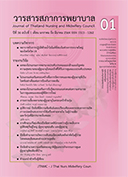Comparison of Clinical Factors in Adult, Young Older,and Older Trauma Patients
Keywords:
trauma, comparison, adult, young older, olderAbstract
Objective: To compare differences of clinical factors involving severity of injury (CRAMS), physiologic deterioration (MEWS), probability of survival (TRISS), length of stay (LOS) and in-hospital mortality rate among adult, young older and older traumatic injury patients.
Design: Retrospective comparative study
Methodology: The researcher recruited a total sample of 627 traumatic injury patients receiving care at emergency department (ED) concerning inclusion criteria. The data from medical records database of Tertiary hospital between 2015 and 2018 were gathered. The instruments for data collection composed of demographic and clinical data at ED visits record forms including severity of injury, physiologic deterioration and probability of survival. LOS and in-hospital mortality were also noted. A sample was divided into 3 groups regarding age; Group I: adult (18-54 years), Group II: young older (55-65 years), and Group III: older traumatic injury patients (over 65 years). Chisquare and Kruskal-Wallis test were employed for statistical analyses with level of signifcance at .05.
Results: The higher the age of a sample group increased, the more the female patients were reported. Overall analysis demonstrated that severity of injury (χ2 =22.76, p<.001), physiologic deterioration (χ2 =21.39, p<.001), probability of survival (χ2=311.83, p<.001) were statistically different among patients with different age groups. As for the analysis of patients having mechanism of injury as blunt injury in different age gropus, the finding revealed the differences among severity of injury (χ2 =18.00, p<.001), physiologic deterioration (χ2 =21.50, p<.001) and probability of survival (χ2 =244.40, p<.001). Additionally, among those with head injury in different age groups, the results indicated that only probability of survival (χ2 =60.00, p<.001) differed. Otherwise, ED LOS and inhospital mortality rate showed no differences (p>.05).
Recommendations: It can be concluded that the selected clinical factors in this study had different impacts on adult, young older and older traumatic injury patients visiting emergency department according to effects from aging adaptation.Therefore, ED nurses need to assess and prioritize which clinical factors should be managed concerning patient’s age, be sensitive for any alterations and monitor those physiologic parameters, specifcally, in older patients as to promote effective physiologic adaptation, maximize probability of survival, and minimize LOS and in-hospital mortality rate.
Downloads
References
Ministry of Public Health. Public health statitics A.D. 2015. Bangkok: Samcharoen Panich; 2015. (In Thai)
Parreira JG, Solda SC, Perlingeiro J, Padovese CC, Karakhanian WZ, Assef JC. Comparative analysis of the characteristics of traumas suffered by elderly and younger patients. Rev Assoc Med Bras. 2010;56(5):541-6.
Department of Older Person. Situation of Thai elderly 2015. Vol.1. Bangkok: Department of Older Person; 2016. (In Thai)
American College of Surgeons. ATLS advanced trauma life support. 10th ed. Chicago: American College of Surgeons; 2018.
Ward RE, Quach L, Welch SA, Leveille SG, Leritz E, Bean JF. Interrelated neuromuscular and clinical risk factors that contribute to falls. J Gerontol. 2019;74(9):1526-32.
Valderrama-Molina CO, Giraldo N, Constain A, Puerta A, Restrepo C, León A, et al. Validation of trauma scales: ISS, NISS, RTS and TRISS for predicting mortality in a Colombian population. Eur J Orthop Surg Traumatol. 2017;27(2):213-20.
Parreira JG, Farrath S, Soldá SC, Perlingeiro JA, Assef JC. Comparative analysis of trauma characteristics between elderly and superelderly. Rev Col Bras Cir. 2013;40(4):269-74.
Wilson MS, Konda SR, Seymour RB, Karunakar MA. Early predictors of mortality in geriatric patients with trauma. J Orthop Trauma. 2016;30(9):299- 304.
Dalton T, Rushing M, Escott M, Monroe B. When grandma breaks: understanding geriatric trauma. JEMS. 2015;40(11):56-62.
Wang C-Y, Chen Y-C, Chien T-H, Chang H-Y, Chen Y-H, Chien C-Y, et al. Impact of comorbidities on the prognoses of trauma patients: analysis of a hospital-based trauma registry database. PLoS One. 2018;13(3):1-12. doi:10.1371/ journal.pone.0194749.
Sammy I, Lecky F, Sutton A, Leaviss J, O’Cathain A. Factors affecting mortality in older trauma patients: a systematic review and meta-analysis. Injury. 2016;47(6):1170-83.
Lee JH, Lee DH. Comparison of injury pattern and clinical outcomes between young adults and elderly patients with alcohol-related injury in South Korea 2011-2016. PeerJ. 2019;7:1-17. doi:10.7717/ peerj.7704.
Roy C, Bakan G, Li Z, Nguyen TH. Coping measurement: creating short form of Coping and Adaptation Processing Scale using item response theory and patients dealing with chronic and acute health conditions. Appl Nurs Res. 2016;32:73-9.
Ludikhuize J, Borgert M, Binnekade J, Subbe C, Dongelmans D, Goossens A. Standardized measurement of the Modifed Early Warning Score results in enhanced implementation of a rapid response system: a quasi-experimental study. Resuscitation. 2014;85(5):676-82.
Chayaput P, Utriyaprasit K, Bootcheewan S, Thosingha O. Coping and health problems of caregivers of survivors with traumatic brain injury. Aquichan. 2014;14(2):170-83.
Junnaruemit K, Thosingha O, Chayaput P, Toskulkaw T. Correlation between adult patients’ emergency room discharge destination and the factors of physiological deterioration severity, age, and comorbidity. Thai Journal of Nursing Council. 2016;31(2):123-32. (In Thai)
Nimthasanasiri A, Chayaput P, Thosingha O, Sanansilp V. Correlation between management of acute pain, severity of Injury, type of surgery and post-operative pain outcome in Injured patients. Thai Journal of Nursing Council. 2013;28(1):111-23. (In Thai)
Gormican SP. CRAMS scale: feld triage of trauma victims. Ann Emerg Med. 1982;11(3):132-5.
Champion HR. Trauma scoring. Scand J Surg. 2002;91(1):12-22.
Jiang X, Jiang P, Mao Y. Performance of Modifed Early Warning Score (MEWS) and Circulation, Respiration, Abdomen, Motor, and Speech (CRAMS) score in trauma severity and in-hospital mortality prediction in multiple trauma patients: a comparison study. PeerJ. 2019;7:1-16. doi:10.7717/peerj.7227.
Plichta SB, Kelvin EA. Munro’s statistical methods for health care research. Philadelphia: Wolters Kluwer Health/Lippincott Williams & Wilkins; 2013.
Wu M-Y, Chen Y-L, Yiang G-T, Li C-J, Lin AS-C. Clinical outcome and management for geriatric traumatic injury: analysis of 2688 cases in the emergency department of a teaching hospital in Taiwan. J Clin Med. 2018;7(9):1-9. doi.
org/10.3390/jcm7090255








